A keen tourist should not wait for a special season or weather to travel to Kharkiv Oblast. The climate hardly makes a difference here, so why not visit it during the winter-spring midseason? It’s possible to get to the largest city of Slobozhanshchyna, a historical region of Ukraine, from anywhere in the country. The Ukrainian Week steps away from stereotypes and looks at this land from a different perspective.
1. Pokrovsky Cathedral
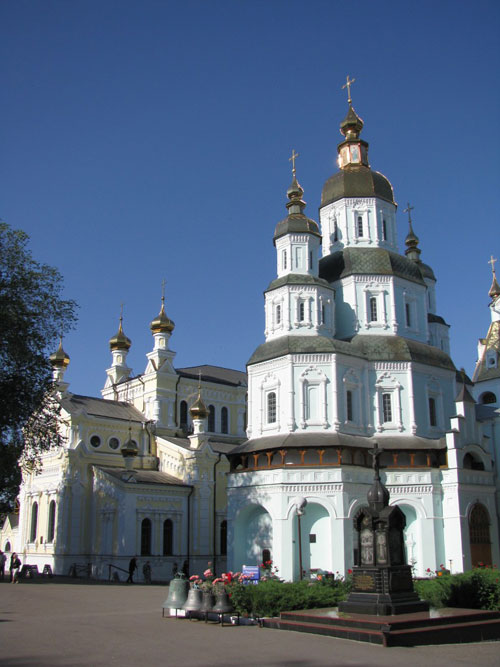
The Pokrovsky or Holy Protection Cathedral, one of the oldest churches in Eastern Ukraine, was built in 1689. Its style is a fusion of Ukrainian baroque and traditional local wooden architecture. The Holy Protection Cathedral is the only remaining part of the original Kharkiv Fortress. It is on these hills, encircled by the current Ploshcha Konstytutsiyi (Constitution Square), Ploshcha Rosy Luxemburg (Rosa Luxemburg Square) and Bursatsky Uzviz, that refugees from Central and Western Ukraine, escaping from The Ruin, founded the future Kharkiv in the mid-17th century. Initially a village with a small fort, thanks to its trade-convenient location, and later the founding of a university and its industrial progress, eventually grew into a city with a population of 1.5-million.
In the 18th century, the Holy Protection Monastery and Kharkiv College were founded on the basis of the Holy Protection Cathedral. The college’s staff included Ukrainian philosopher and writer Hryhoriy Skovoroda and composer Artemy Vedel. Soviet authorities closed down the cathedral, and left it balanced between restoration attempts and ultimate destruction. At one point, its dungeons and empty rooms on the upper floors were an attraction for urban explorers. Today, the cathedral has been restored and handed over to the Moscow Patriarchate.
2. Art Nouveau in Kharkiv
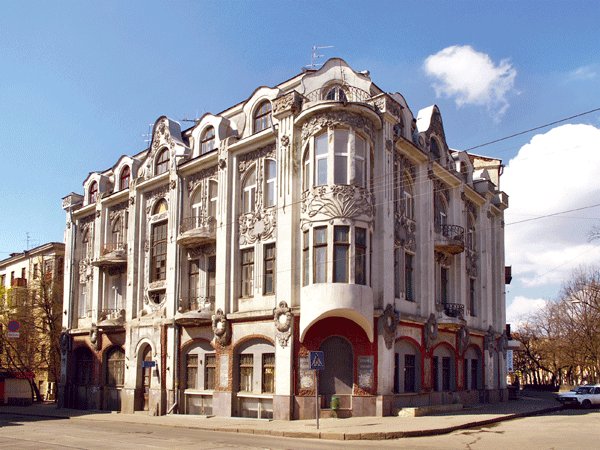
The architectural image of Kharkiv is often thought of as being composed of soviet box and cube-like apartment blocks, plus factories. But you will see a whole lot of cute pre-revolutionary buildings as you walk along the downtown streets, such as Sumska, Pushkinska and others. Most are in the Modern style, one more commonly known in the West as Art Nouveau or Secession; lavishly decorated with slender floral lines, surprising proportions and mystical elements. The Kharkiv version of Art Nouveau is somewhat different than that found elsewhere in Ukraine. On the one hand, it sports a clear trace of North and West European influence, but on the other, it offers several interesting examples of the style’s local “ethnographic variations”. One is the former College of Arts, which has since been transformed into the Design and Arts Academy, built in 1913 in the classical Ukrainian Art Nouveau style by Kostiantyn Zhukov. Another architect, Oleksandr Ginsburg built more than 20 buildings in Kharkiv, including the magnificent multi-family residential building on the corner of Pushkinska Street and Ploshcha Poezii (Poetry Square). The pre-revolutionary advertisement boards there have also been restored.
3. The Synagogue
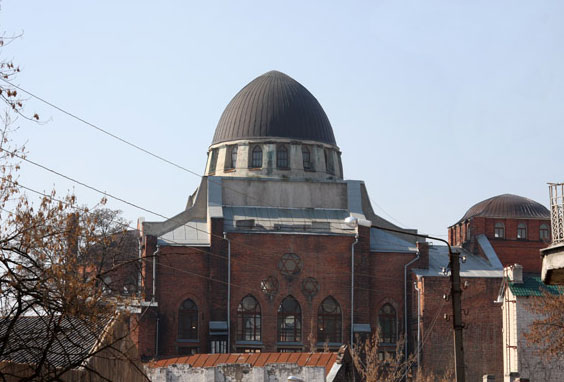
It is often called one of the biggest synagogues in Europe. You may have gathered by now that the locals really like the “–est” suffix. Even though the local Jewish community was never as numerous or powerful as in Central, Western and Eastern Ukraine, the local choral synagogue is a monumental building. It was built in 1913, based on Yakov Gevitz’s design in the specific Mauritanian-Gothic style.
During the Soviet era, it played host to various institutions, including the Jewish Workers’ Club of the Third International, a children’s movie theatre, and Spartak, a voluntary athletic community. The latter stayed there until 1990 when the synagogue was returned to the Jewish community. It took years to restore the gyms back into a prayer hall.
Reform and Hasidic Jews fought over the Kharkiv choral synagogue for several years, the former led by Eduard Khodos, a controversial figure known for burning the US flag and stigmatizing the “Jewish mafia” in his books.
4. The House of State Industry
Soviet heritage is an integral component of Kharkiv’s modern image. The House of State Industry at Ploshcha Svobody (Liberty Square, considered to be the largest in Europe) is a perfect model of 1920s Constructivism. At that time, Kharkiv was the capital of Soviet Ukraine and the authorities had to put trusts, banks and other institutions somewhere. They announced a tender and the winner was The Intruder, a project by Leningrad architects Sergei Serafimov, Samuil Kravets and Mark Felger. When building the foundations, the builders unexpectedly dug up mammoth bones.
We will not compare the State Industry House with Chicago and New York as Soviet propaganda did, but the building really is interesting and original, massive yet lofty. Rumour has it that the intervals between the heights of its different towers reflect the melody of “International”, the Soviet anthem. Apart from trusts and banks, the State Industry House hosted the then government, known as the Council of People’s Commissars. Mykola Skrypnyk, a Ukrainian Bolshevik leader who supported the Ukrainization campaign in Soviet Ukraine, shot himself in one of the building’s cabinets on 7 July 1933. During WWII, it sheltered monkeys from the abandoned local zoo. To this day, some of its authentic elevators, installed in the 1920s, still work. Each one has a female elevator operator. She sits on a small stool in the elevator, talking on the plastic telephone located above her head for hours on end.
5. The Shot Renaissance
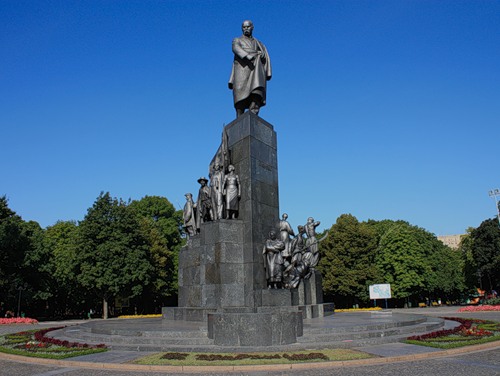
The abovementioned 1920s were arguably the most fruitful years in terms of Kharkiv’s contribution to Ukrainian culture. It was then that many artists from all over the country lived and created their art in Kharkiv. The Berezil theatre, the crossing of Serhii Vasylkivsky’s realistic school with the avant-garde explorations of Anatoliy Petrytsky, Vasyl Yermilov and others, the Shot Renaissance of writers – the memory of all this is preserved in the narrow circles of the intellectual elite. The average visitor walking the city’s streets will hardly notice it. Still, some traces of this legacy remain.
The Lyrics building on Kultury Street near the Naukova metro (underground) station had been home to hundreds of writers from the Shot Renaissance generation, including Mykola Khvylovy, Mykola Kulish, Mykhailo Semenko and Valeriy Polishchuk. They were all arrested here, and this was where Khvylovy shot himself. Its current dwellers have nothing to do with literature. The only reminder is the memorial plate that lists writer Mykhailo Yalovy twice: under his own name and his pen name, Yulian Shpol.
Another controversial site is the monument to Taras Shevchenko built by Matviy Manizer in 1935. Ironically, the dynamic sculptural ensemble includes the a statue of Kateryna posed for by Berezil actress, Natalia Uzhviy and her son, she being the wife of poet Mykhailo Semenko who often tarnished Shevchenko’s iconic status in his poems. Legend has it that your secret wish will come true if you happen to see a tractor wheel behind one of the monument’s figures.
The local Literature Museum will tell you more about the present and the past of the writers’ scene in Kharkiv. In addition, you can see the extensive collection of the Art Museum, modern art at the City Museum and Yermilov Centre, a concert at the philharmonic or a play at the Taras Shevchenko Theatre – the former Berezil (modern theatre director Andriy Zholdak tried to restore the old name with no success); the Arabesques theatre, or Theatre 19. The city also has a more or less art-house – the “Bommer” movie theatre.
6. The Assumption Cathedral
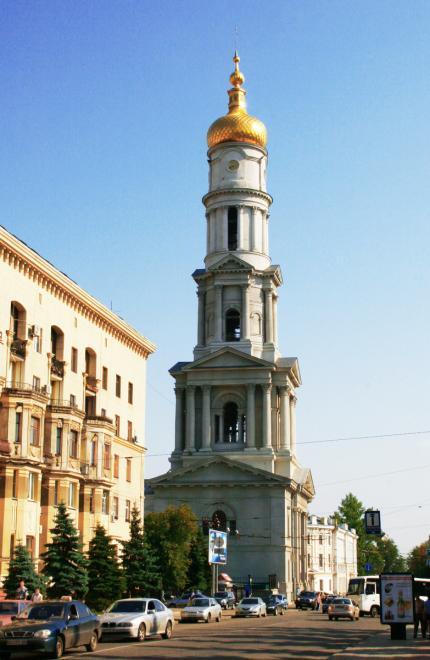
The Assumption Cathedral is the highest building in downtown Kharkiv. It was supposedly built in the Baroque style in 1771-1778 to resemble the St. Clement’s Church in Moscow, although the result is far from identical. The iconostasis was painted based on sketches made by Francesco Rastrelli but it did not survive. The 89-metre high bell tower was built in 1821-1844 as a dedication to the victory of the Russian Empire over Napoleon. Built entirely in the Classicism style, it is crowned with an onion dome that does not quite fit into the style.
After the revolution, the cathedral was shut down. Used as a radio station, it gradually lost its frescoes and other decorations. After the war, it played host to a sewing and painting workshops. The restoration began in the 1970s followed by the installation of an organ in 1984. The cathedral is still used as a philharmonic hall for organ concerts but will be designated for purely religious purposes once the local authorities set up an alternative hall.
7. Skovorodynivka
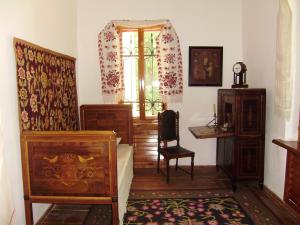
This village in the Zolochiv Region was previously called Pan-Ivanivka. The local landlord, Andriy Kovalevsky, had the prominent Ukrainian philosopher, Hryhoriy Skovoroda, as his house guest at different times during 1790-1794. According to some sources, it was here that Skovoroda wrote his “Snake Deluge” dialogue and “The Prayer to God for Kharkiv City”, a poem in Latin in which he described Kharkiv as “God’s seventh eye”. This is also where the philosopher died and a museum dedicated to him was established in 1972.
The Hryhoriy Skovoroda National Literature Memorial Museum is open all week. Although small, the exhibit is interesting and well-compiled, especially the part dedicated to Skovoroda’s biography. The collection includes some of his personal things. Make sure that you see the landlord’s rooms furnished in the 18th century, the park with ponds and eye-catching hills, Skovoroda’s oak tree and the well. Nearby is Skovoroda’s grave, which he dug for himself. The inscription on it, requested by the philosopher, says “The world tried to catch me, but never did”.
8. Sharivka
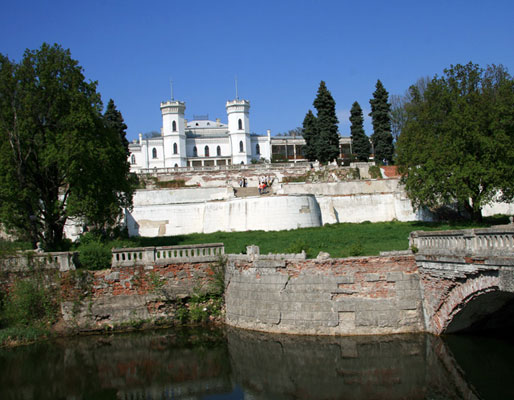
A nice mansion is located in the village of Sharivka in the Bohodukhiv Region. You can get there by bus from the bus station at Kharkiv Central Market, but ideally, a car would be best.
The village was founded by the Cossack Shariy. It later belonged to military commander Petro Olkhovsky. He began to build a palace but lost it in a card game. The mansion’s most glorious time was under Baron Leopold Kenig, who owned distilleries and sugar plants. Under the Soviet regime, it was used as a sanatorium for those suffering from tuberculosis.
Sharivka palace and park are not in the best shape today, but they still offer glimpses of the pearl of Slobozhanshchyna that they used to be. This is just another incentive for visiting them soon, before everything falls apart or becomes the victim of a restoration project. The romantic neo-Gothic mansion with its towers, the accounting house built in the German style, the Medieval-looking entrance building, a hunters’ lodge, ponds, wooded slopes and linden alleys… There is also a legendary stone on the territory. Rumour has it that it came from Crimea. Apparently, Leopold Kenig’s wife cheated on him on this stone. When he found out about the adultery, he didn’t say a word to his wife but ordered for the stone to be delivered to Sharivka and placed in the middle of her favourite alley.
9. Natalivka
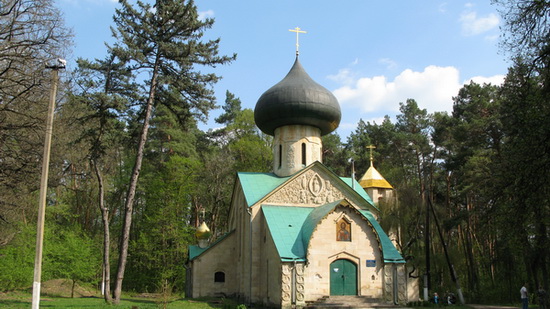
Next to Sharivka is a village called Volodymyrivka with yet another beautiful mansion and park. It was built in the late 19th century by sugar mogul Pavlo Kharytonenko. Natalivka is named after his daughter Natalia. The local climate cured the girl from tuberculosis. To celebrate this, her father built the Church of Transfiguration in 1911-1913 using a project by architect Alexei Shchusev who designed the Lenin Mausoleum. Its architectural style is quite rare in Ukraine as it combines Art Nouveau with ancient Rus church architecture. The proportions, decorations and forms of the church are impressive and unusual, while the bell tower looks like a rocket. The church was previously adorned with antique icons from the mogul’s collection.
In addition to the church, the village boasts a beautiful entrance gate, an annex, household buildings, and stables. There is also a nice, but neglected park.
10.Izium

Referred to as the “southern capital”, Izium is the second largest city in Kharkiv Oblast, founded in the mid-17th century just like virtually all the other settlements in Slobozhanshchyna. Some historians, as well as local legends, claim that the Cossack fortress of Izium emerged on the Kremianets hill, where there used to be Tartar fortifications and a settlement called Uzun-Kermen. Finding out more about Izium’s distant past is a challenge, as the local ethnographic museum reveals little. Currently, the Kremianets hill is home to a group of stone figures and a large monument dedicated to WWII battles. It also offers panoramic views of the Siversky Donets valley and the beginning of the Donetsk Ridge.
The Cossack Transfiguration Cathedral, built in the 17th century, is also located in Izium. Its style resembles that of the Holy Protection Cathedral in Kharkiv, yet the one in Izium looks “lighter” and more compact. In the 19th century, it was remodeled to suit the architectural preferences of that time, but was later restored to its original form. Another attractive site is the Church of the Exaltation of the Holy Cross built in the Classicism style.
Other interesting spots include the old local private sector, and a weird-looking monument to political instructor Mikhailov, who was killed “by a bandit” in 1923. Designed in the typical style of those years, the monument is further proof of the difficulties faced by Bolshevik experiments, even in Eastern Ukraine.

